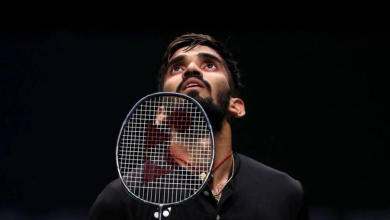Lessons from first T20: India should think twice before preparing turning wickets this season

Turners are a rarity in T20 cricket. The unfamiliarity manifested in Ranchi, as spinners of both sides prospered; India’s trio of Washington Sundar, Kuldeep Yadav and part-timer Deepak Hooda conceded only 56 runs for three wickets in 10 overs; New Zealand’s threesome of Mitchell Santner, Michael Bracewell and Ish Sodhi gave away 72 runs in eleven overs, but shared five wickets among themselves.
It was a shootout of spinners that New Zealand emerged victorious— 21 runs. This should rankle India even more, that they lost on a turner, their strongest suit, where they are expected to shrug off opponents with the ease of swatting a pesky fly aside. Except that, in every department, New Zealanders trumped the Indians, be it bowling spin, playing spin or chalking out a workable method to bat on the surface, or reading the nature of surface (India picked three seamers plus Hardik Pandya and benched Yuzvendra Chahal). In a sense this was a less, or perhaps a warning, that if India are to dish out turners in the season, be it during Tests, the 50-over World Cup, or T20Is, they better ensure that they utilise the conditions, soul-search whether they indeed have the requisites, the mind and skills, to successfully pass the spin trials. Lest it could horribly backfire, as it did during the group game between these two teams in Nagpur during the 2016 T20 World Cup.
You could argue that this was not India’s first-choice eleven, but then you could argue that this is not exactly a second-string either, more so the top six, whose adeptness against spin would be scrutinised. The travails of modern-day Indian batsmen against spin — a line of argument the old-timers constantly rub in, and not without reason either — was ruthlessly exposed. Perhaps, unlike Test matches, a T20 batting unit is not picked on their merits of encountering spin, but when they encountered such a pitch, they simply froze, like stepping into the Arctic zone in jogger pants.
That’s that from Ranchi.
New Zealand win the first T20I 21 runs in Ranchi.#TeamIndia will look to bounce back in the second #INDvNZ T20I.@mastercardindia pic.twitter.com/Lg8zmzwYVH
— BCCI (@BCCI) January 27, 2023
Perhaps, no passage of the game illustrated India’s weakness as much as Santner’s last over to Deepak Hooda. The Rajasthan batsman is considered a proficient player of spin, he is a domestic veteran and boasts an average of 47 in first-class. So presumably, a batsman of this domestic experience, even though in the longest format, is supposed to deal with the spinners with a certain degree of comfort. Here, he was hideous. The first ball he faced, he backed away and tried to manufacture room and smear him over cover. His swipe missed the ball a mile. The next ball, he stepped out, the last resort of Indian batsmen these days to spin, misread the flight and was only saved off a stumping an inside edge onto the body. He got out the next ball, again stepping out, reaching nowhere close to where the ball landed and swinging cluelessly at the ball. To a left-arm spinner purchasing a copious amount of turn away from the right-handed batsman, he was looking to heave over mid-on. A dangerous method even at the best of times.
It is harsh to single out Hooda alone. Even Suryakumar had his troubles in neutering Santner, who deliciously interchanged his line, length, trajectory and speed. As efficient as India’s spinners were, Santner and Co, were better. Santner beat him thrice at least, once off a drive, then off a cut and reverse sweep. That he played out a maiden sums up the threat he whipped up on a surface that gripped and turned, even at the onset of dew in the evening. He missed another reverse sweep off Sodhi. Worse, he could not rotate strike as adroitly as he often does. Santner’s armer spooked him, as did variable bounce.
I. C. Y. M. I
How about that for a comeback from @Sundarwashi5 👏 👏 #TeamIndia | #INDvNZ | @mastercardindia
Watch 🎥 🔽https://t.co/y9w3fQWV8W
— BCCI (@BCCI) January 27, 2023
That he still thrived testified his quality. Only someone with his shots, method, touch and bravado could muster runs. After realising that Santner was best played safely, he plotted plans to attack Sodhi. The leg-spinner was delectably swept for a brace of boundaries, one behind square and the other in front of square, one a stroke of sophry and the other of brute force, before he was creamed over extra-cover for a sumptuous six. The ball after the six, he perished, and with him took India’s hope. His wariness against spinners meant that the seamers bore the brunt. He didn’t spare the bustling Lockie Ferguson either, as New Zealand’s enforcer was bunted over the fine-leg fence. Later, Blair Tickner was lasered either side of the point fielder. Sadly for India, no one else could impersonate him, even palely.
Not even Shubman Gill, who has been in gorgeous touch. He floundered trying to pull Santner, but the ball got big on him and turned sharply away from him. It was a classic case of not sizing up the characterics of the pitch. His opening partner Ishan Kishan was leaden footed against the off-spinner Bracewell and merely pushed at the ball from the crease to be bowled. Later, Bracewell gobbled up a well-set Pandya, who played for turn when the ball went straight on. Perhaps, it was a natural variation, but the selection of shot, a pull, was not the most judicious one. Thus, most of the wickets owed more to the indiscretion of the batsman than the guiles of the bowler or the devil on the wicket.
That said, it was not as horrendous a pitch as some of the deliveries made it look. After all, New Zealand did manage to put on 176, and India for all their shambolic batting, did reach 155/9. The visitors’ plan was simple — play out the spinners and punish the seamers. Devon Conway was more enterprising against the spinners, he swept, reverse-swept and came down the track to them with success in his 35-ball 52, but Daryl Mitchell, whose unbeaten 59 off 30 balls propelled them to the winning score, counted entirely on seamers to accelerate. None felt the pangs as much as Arshdeep Singh, as he plundered 27 runs off his last over, that is nearly half the runs he scored.
FIFTY for @Sundarwashi5 🙌🙌
Maiden T20I half-century off 25 deliveries for Washington Sundar.
Live – https://t.co/9Nlw3mU634 #INDvNZ @mastercardindia pic.twitter.com/xtX8fZwOSk
— BCCI (@BCCI) January 27, 2023
There was a lesson in this too—that even on a turner, you need your seamers to support the spinners, especially in white-ball formats. Nonetheless, the pitch could offer introspection, whether a turner in white-ball cricket is a strength or weakness for India.
Brief scores: New Zealand 176/6 in 20 overs (Mitchell 59 n.o, Conway 52, Washington 2-22) beat India 155/9 in 20 overs (Washington 50, Suryakumar 47, Santner 2-11) 21 runs







